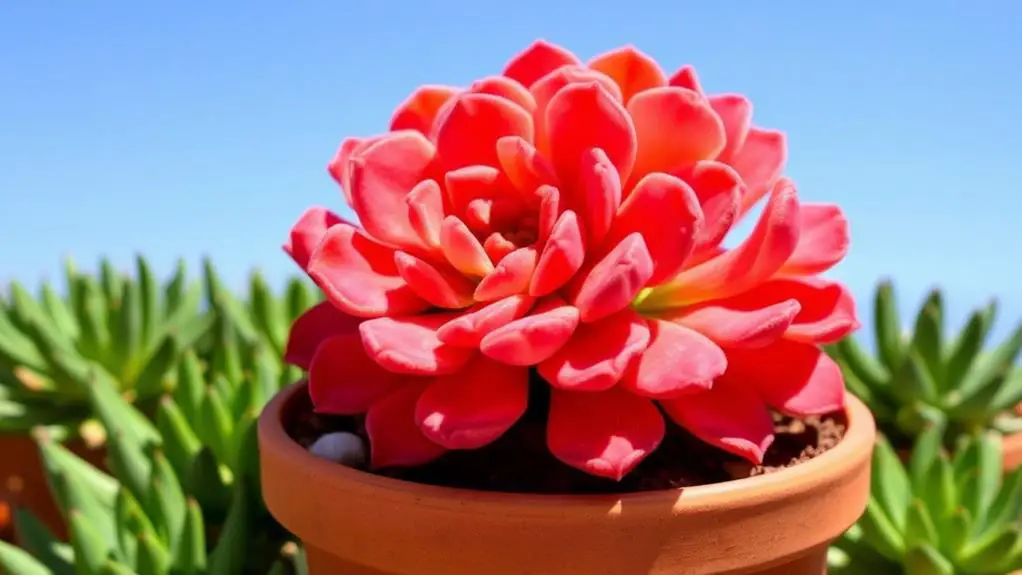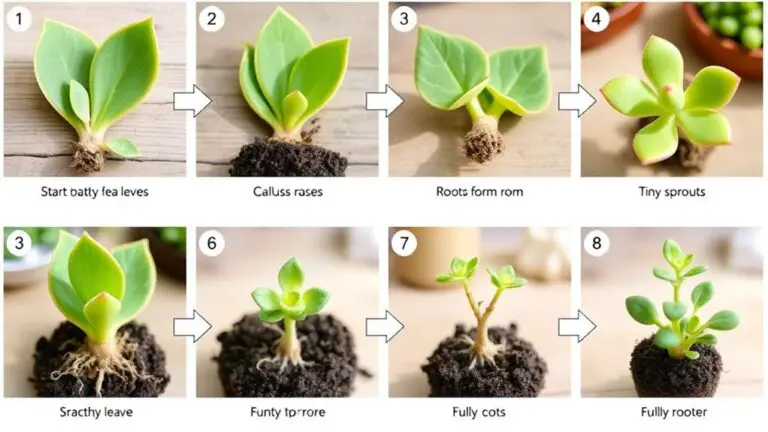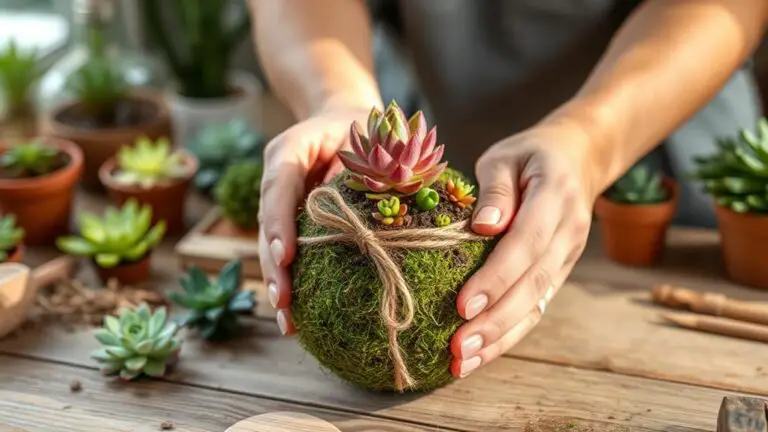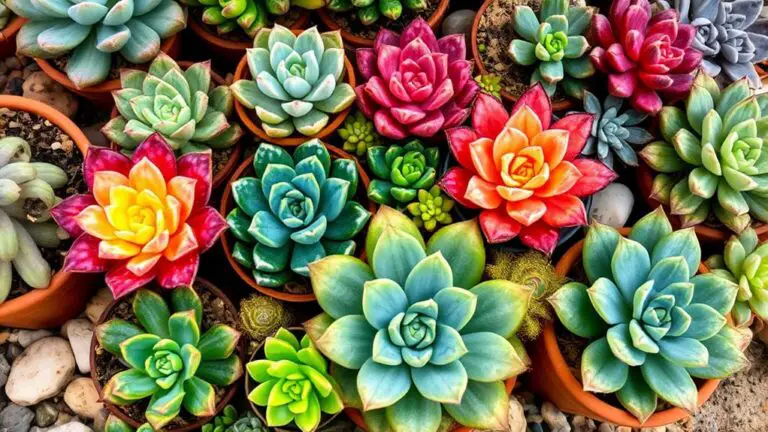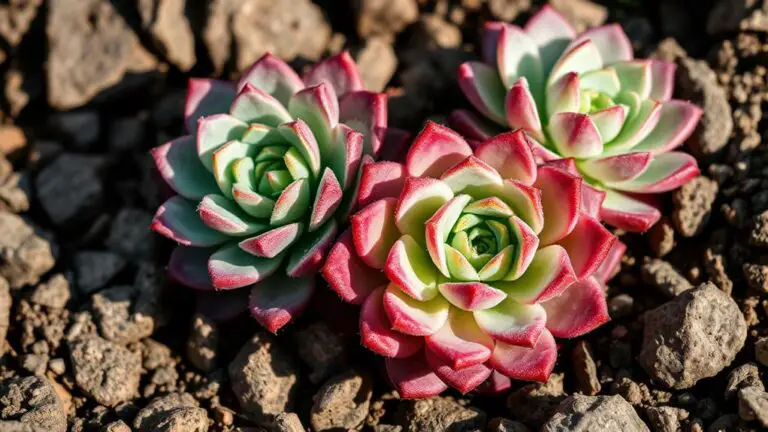10 Essential Tips for Graptosedum ‘California Sunset’ Care
Caring for your Graptosedum 'California Sunset' can be straightforward if you follow these ten essential tips. Start with ensuring it gets plenty of bright, direct sunlight for about 4-6 hours each day. You'll also want to use well-draining soil and adopt the soak and dry watering method to prevent root rot. But that's just the beginning. Fertilizing monthly during the growing season and pruning to maintain its shape are equally important steps. Curious about repotting, pest control, or propagation techniques? Let's explore how these practices can keep your succulent thriving.
Optimal Light Conditions
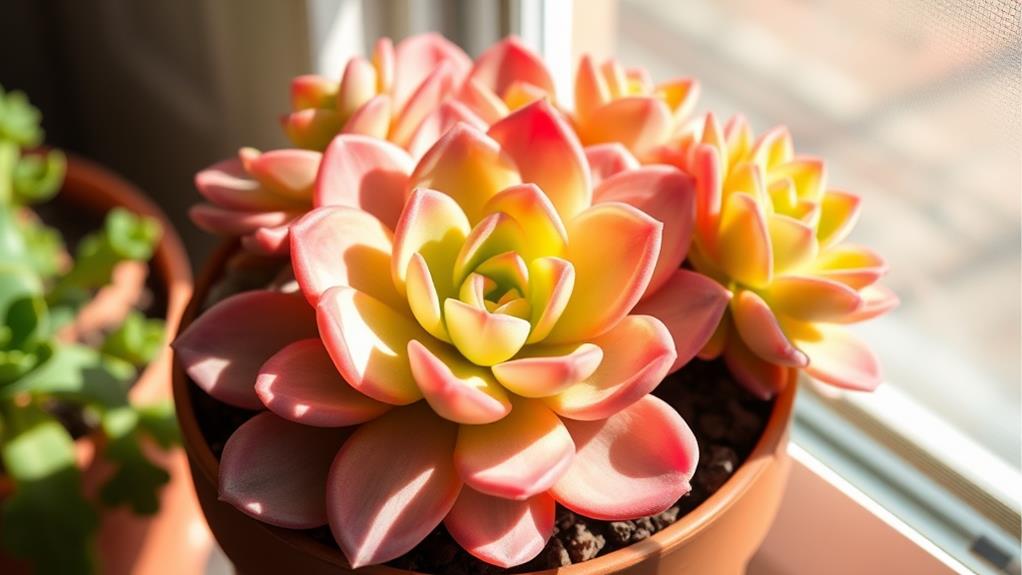
Graptosedum 'California Sunset' shines best when it gets plenty of bright, direct sunlight. For ideal light conditions, place your plant near a sunny window, ideally one that faces south or west. This guarantees it receives 4-6 hours of bright sunlight each day, promoting vibrant colors and strong growth.
While it can tolerate partial shade, keep in mind that too little light will result in less vivid hues and weaker growth. If you live in a hot climate, be cautious of the intense midday sun, which can scorch the leaves.
Regularly monitor the light your plant receives, especially during seasonal changes, to make certain it continues to thrive. Your Graptosedum will thank you with its beautiful, sunset-like leaves!
Proper Watering Techniques
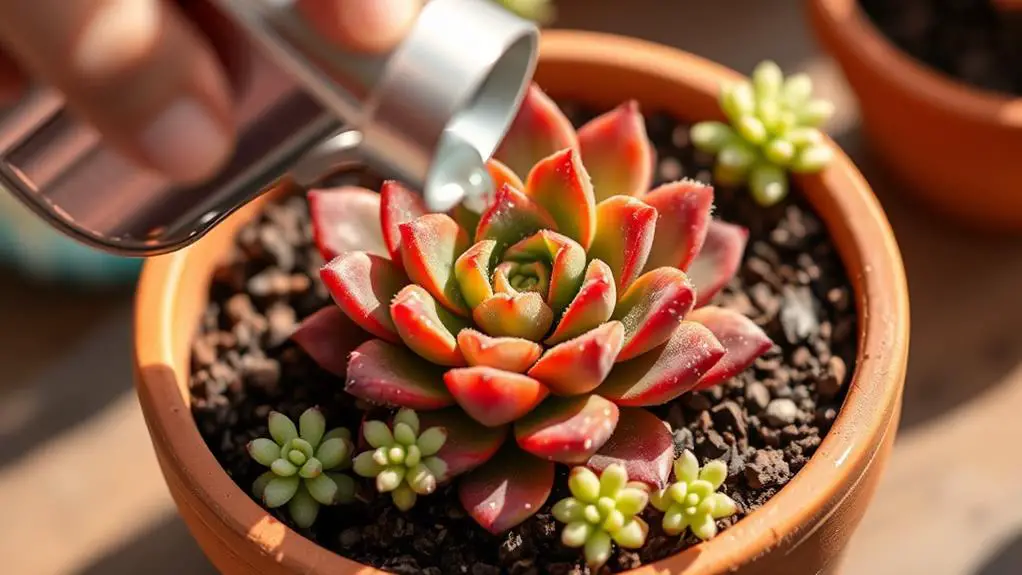
When it comes to watering your Graptosedum 'California Sunset,' it's important to use the soak and dry method.
Make sure the top 2-3 inches of soil are completely dry before watering again to prevent root rot.
Remember to adjust your watering frequency in the winter and watch for signs of overwatering or underwatering, like yellowing leaves or shriveled stems.
Soak and Dry
The "soak and dry" method is essential for ensuring your Graptosedum 'California Sunset' thrives.
To use this method, first water your plant thoroughly until water drains from the bottom. Make sure you're using well-draining soil and pots with drainage holes to prevent water from sitting around the roots.
After watering, let the soil dry out completely before the next session. You'll know it's time to water again when the top 2-3 inches of soil feel dry to the touch.
This technique helps you avoid overwatering, which can lead to root rot. Remember, the key is to soak your plant and then let it dry out fully, ensuring it gets the right amount of water without drowning.
Frequency and Signs
Proper watering techniques are essential for maintaining a healthy Graptosedum 'California Sunset.'
Water sparingly, ensuring the top 2-3 inches of soil dry out completely between sessions. Typically, you'll need to water about 0.5 cups every 12 days.
This succulent thrives on the soak and dry method: water thoroughly until excess drains out, then wait until the soil is fully dry before the next watering.
Be cautious of overwatering; yellowing leaves, mushy stems, and foul-smelling soil are all signs.
Underwatering is indicated by shriveled or wrinkled leaves. In this case, a thorough watering helps restore the plant's health.
Adjust your watering frequency based on humidity levels.
Stick to these guidelines, and you'll keep your Graptosedum thriving!
Seasonal Adjustments
As seasons change, so should your approach to watering Graptosedum 'California Sunset.'
During the growing season, typically spring and summer, increase watering frequency in response to warmer temperatures and higher humidity levels, but make certain not to leave the plant in standing water to prevent root rot.
Check soil moisture regularly and let the top 2-3 inches dry out completely before watering again.
In winter, reduce your watering schedule since the plant needs less moisture.
Adjust based on sunlight; more light means more frequent watering, while less light means less.
Always watch for shriveled leaves (a sign of dry soil) or yellowing, mushy leaves (a sign of overwatering).
This way, you'll guarantee your plant thrives year-round.
Choosing the Right Soil
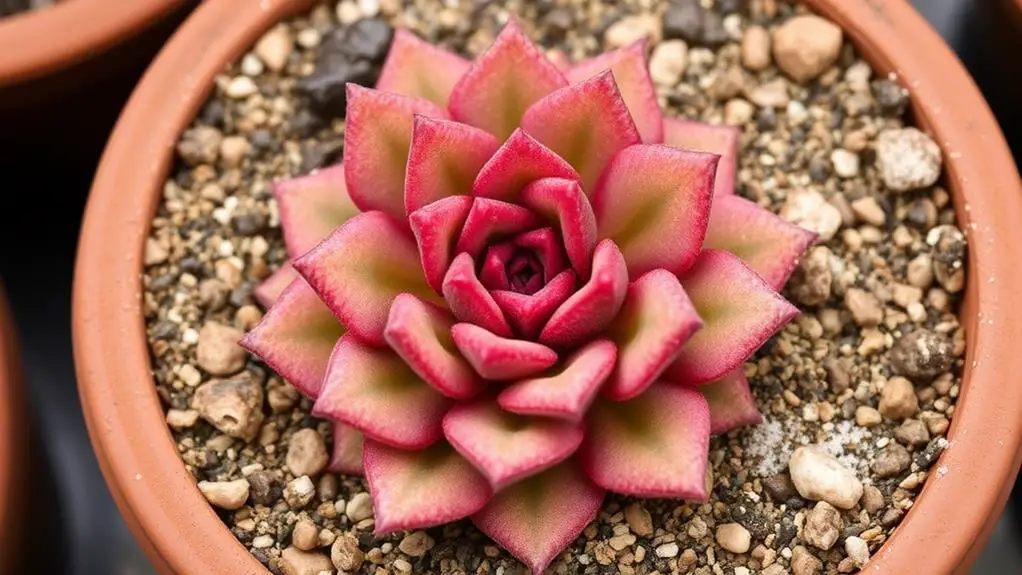
Selecting the ideal soil for Graptosedum 'California Sunset' is crucial for its health and growth. You need well-draining soil to prevent root rot and promote thriving roots.
A cactus or succulent mix with coarse sand, pumice, or perlite works best. This mix guarantees the soil dries quickly and stays airy, which your plant loves. Avoid rich, moist soil since it retains too much water and can cause problems.
When potting, use dry soil and hold off watering for about a week to let the roots settle. Regularly repot every 2-3 years with fresh soil to keep it healthy and growing strong.
Effective Fertilization
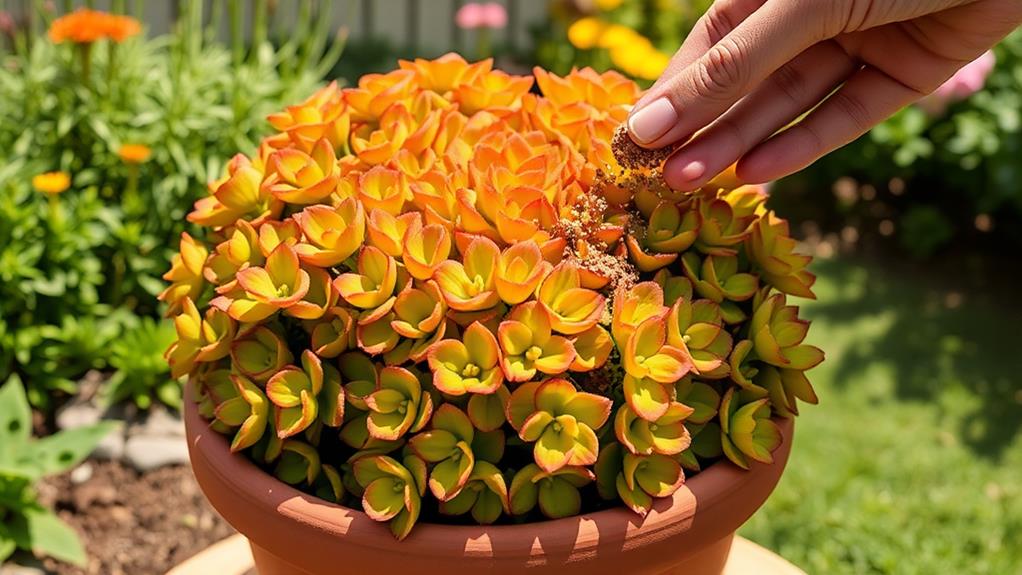
Nurturing your Graptosedum 'California Sunset' with the right approach to fertilization can make a world of difference in its vibrancy.
Use a balanced, water-soluble fertilizer monthly during the active growing season. Most potting soils have enough nutrients at first, so only consider fertilizing if growth seems slow or if you notice signs of nutrient depletion, like yellowing leaves.
Be careful not to over-fertilize, as this can cause root burn and stress, leading to stunted growth. Remember to stop fertilizing during the winter dormancy period, allowing your plant to rest.
Regularly check your plant's health to decide when it needs fertilization, ensuring well-draining soil to prevent nutrient buildup. This helps keep your Graptosedum thriving.
Ideal Temperature and Humidity
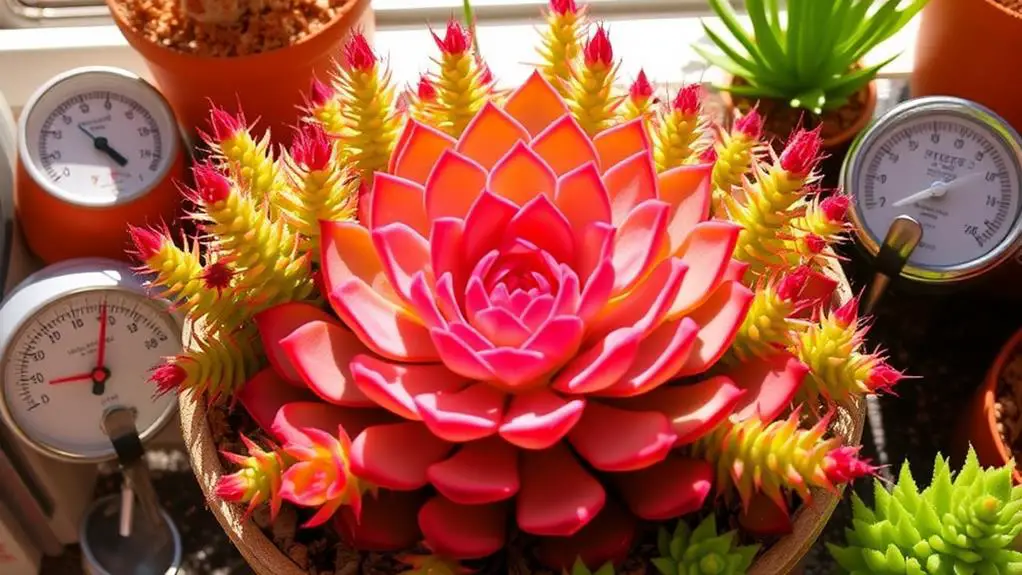
To keep your Graptosedum 'California Sunset' happy, aim for temperatures between 60°F and 80°F, which are perfect for indoor settings.
It can handle colder temperatures down to 30°F, but try to shield it from the cold to avoid damage.
Maintain humidity levels between 30-50%, ensuring good airflow to prevent rot and fungal issues.
Optimal Temperature Range
While guaranteeing Graptosedum 'California Sunset' thrives, pay close attention to its ideal temperature range.
This plant flourishes in temperatures between 60°F and 80°F (15°C to 27°C). For best plant care, remember that it's sensitive to cold and can't handle prolonged exposure below 30°F (-1.1°C).
If temperatures drop below 40°F (4°C), you'll need to protect it to prevent damage. When grown outdoors in warmer climates, monitor temperature fluctuations and provide shade during extreme heat to keep your plant safe.
Keeping within this best temperature range will help your California Sunset thrive. By paying careful attention to these temperature needs, you'll guarantee your plant continues to grow healthily and beautifully, making your gardening efforts worthwhile.
Humidity Level Preferences
Maintaining the right humidity level is essential for the health of your Graptosedum 'California Sunset'. This succulent thrives in moderate humidity levels, ideally between 30-50%.
Too much moisture can lead to root rot, so make sure your soil is well-draining. Aim for temperatures between 60°F and 80°F.
If you grow your plant indoors, especially during winter when the air can get dry, monitor the humidity closely. Good airflow is also important to prevent fungal issues, especially in more humid environments.
Cold Protection Measures
When temperatures start to drop, it's vital to protect your Graptosedum 'California Sunset' from the cold. This plant isn't cold hardy and can suffer damage if exposed to temperatures below 30°F (-1.1°C).
Ideally, you want to keep it in a spot where temperatures range from 60°F to 80°F.
During winter, move your plant indoors or to a sheltered area to avoid frost exposure. Make sure the place has moderate humidity levels between 30% and 50%.
Too much moisture can lead to rot, especially in cooler temperatures. Good airflow is also important to prevent moisture problems.
Potting and Repotting
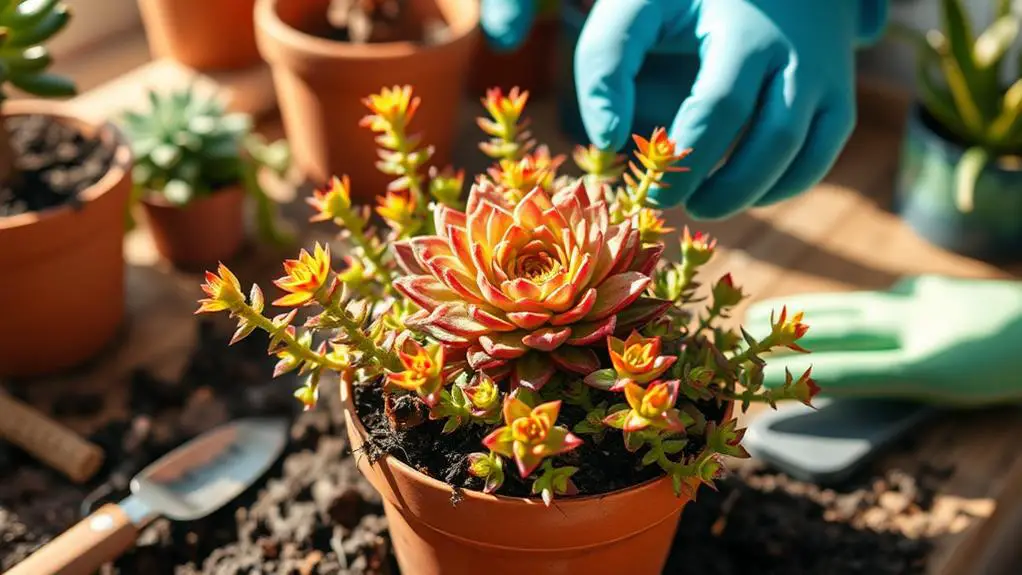
Repotting your Graptosedum 'California Sunset' is crucial to keep it thriving and healthy.
Start by choosing a pot with drainage holes to prevent root rot. Use a well-draining soil mix—ideally, 50% to 70% mineral grit like coarse sand, pumice, or perlite. This mix guarantees maximum growth.
Repot every 2-3 years during the growing season, especially when your plant has doubled in size. Water the plant a few days before repotting to make removal easier.
When potting, place your plant in the new pot and add the well-draining soil. Let the soil dry completely before watering again to avoid overwatering stress.
Following these steps will help your Graptosedum 'California Sunset' stay healthy and vibrant.
Pruning Best Practices
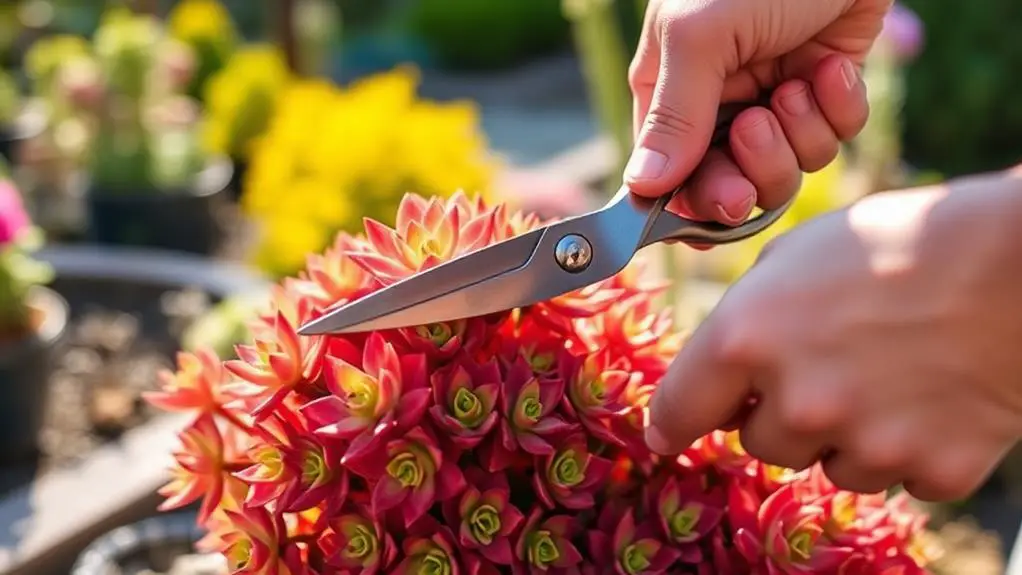
After repotting your Graptosedum 'California Sunset', it's important to focus on proper pruning to guarantee your plant stays healthy and attractive. Prune during the active growth season using clean, sterilized shears. This helps prevent disease transmission. Remove any damaged or dead leaves to maintain airflow and reduce pest risks. Regularly check for overcrowding and remove offsets to prevent competition for nutrients and space.
| Pruning Task | Why It's Important |
|---|---|
| Remove Dead Leaves | Promotes airflow, reduces pest risk |
| Check for Overcrowding | Prevents nutrient competition, maintains shape |
| Callous Cuttings | Prevents rot during propagation |
Pruning also controls the size and shape of your plant, keeping its compact rosette form. If you plan to propagate, let the cuttings callous for 1-2 days before planting.
Propagation Methods
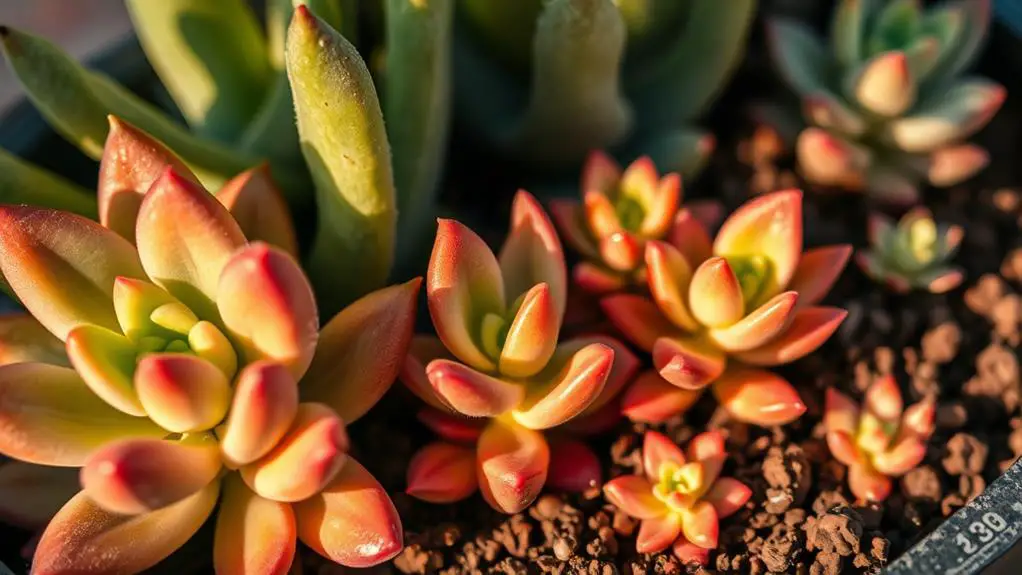
Propagating Graptosedum 'California Sunset' is straightforward and rewarding, offering several methods to grow new plants. To propagate Graptosedum California successfully, follow these tips:
- Stem Cuttings: Cut a healthy stem below a leaf node. Let it callous for 1-2 days, then plant in well-draining soil.
- Leaf Propagation: Gently pull healthy leaves from the stem. Allow them to callous for a few days, then place on well-draining soil without burying them.
- Offsets: Remove offsets with roots and leaves. Dry for 1-2 days before planting in moist, well-draining soil.
- Seeds: Collect seeds after blooming. Sow them in potting soil, keeping them warm for several weeks until they germinate.
Keep new plants in indirect sunlight and slightly moist soil to encourage root development.
Common Plant Issues
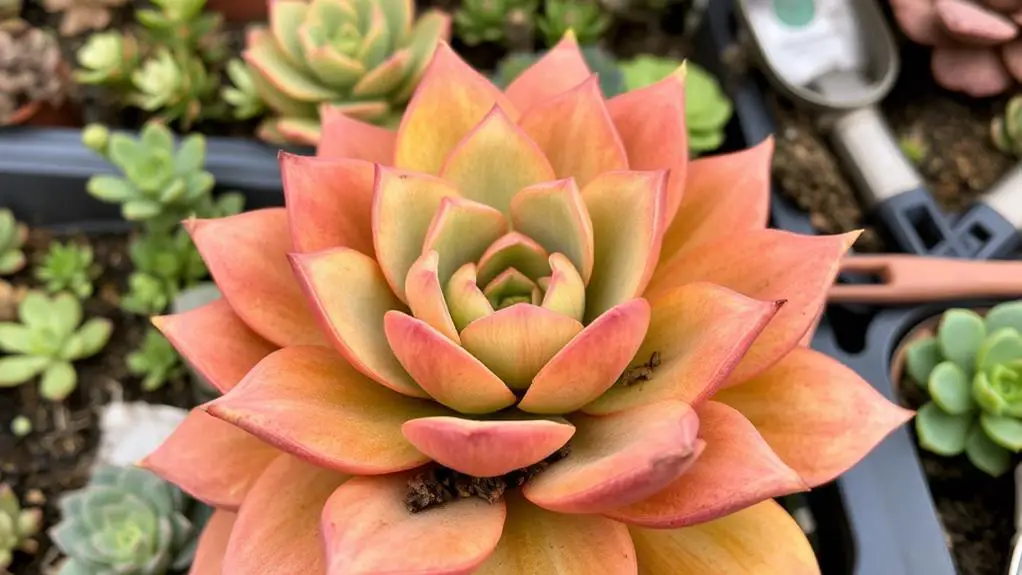
When caring for your Graptosedum 'California Sunset', watch out for common issues like overwatering, pests, and sunburn.
Overwatering can lead to root rot, so let the soil dry completely between watering sessions.
Also, keep an eye out for pests and avoid too much direct sunlight to prevent leaf damage.
Overwatering and Root Rot
Overwatering is a frequent pitfall for Graptosedum 'California Sunset' enthusiasts, often leading to the dreaded root rot. To avoid this, monitor soil moisture carefully. Allow the top 2-3 inches of soil to dry out completely before you water again.
Watch for signs like yellowing leaves, mushy stems, and a general decline in plant health, which all indicate overwatering and the potential start of root rot.
Here's what you can do to prevent these issues:
- Use well-draining soil and pots with drainage holes.
- Confirm the soil dries out completely between waterings.
- If root rot occurs, remove the plant and trim affected roots.
- Repot in dry soil to help the plant recover.
These steps will keep your plant healthy and thriving.
Pests and Infestations
Even with the best care, Graptosedum 'California Sunset' can fall victim to pests and infestations, which are common plant issues.
Mealybugs, aphids, and spider mites are the usual culprits, sucking the sap and weakening your plant. Look for sticky residue, webbing, and visible insects as signs of infestation. Regularly inspect your plant to catch problems early.
Insecticidal soap or neem oil can treat infestations effectively. Maintaining proper care, like avoiding overwatering and ensuring good air circulation, helps prevent these pests.
Remove affected leaves promptly and monitor your plant closely to aid recovery and stop further infestations. By staying vigilant and proactive, you can keep your Graptosedum 'California Sunset' healthy and thriving.
Sunburn and Light Stress
Exposure to excessive direct sunlight can cause sunburn on your Graptosedum 'California Sunset', manifesting as unsightly brown patches on its leaves.
To prevent sunburn and light stress, provide bright but indirect sunlight, especially during peak hours. When you notice leggy growth or stretching, it's a sign your plant isn't getting enough light. Adjust its placement gradually to help it adapt.
- Acclimate slowly: Begin with 1-2 hours of direct sunlight and increase exposure gradually.
- Monitor watering: Overwatering combined with high light can worsen stress.
- Peak hours caution: Shield your plant from intense midday sun.
- Leggy growth: Move your plant to a brighter spot if it stretches.
Following these tips will keep your Graptosedum thriving and sunburn-free!
Safety and Toxicity
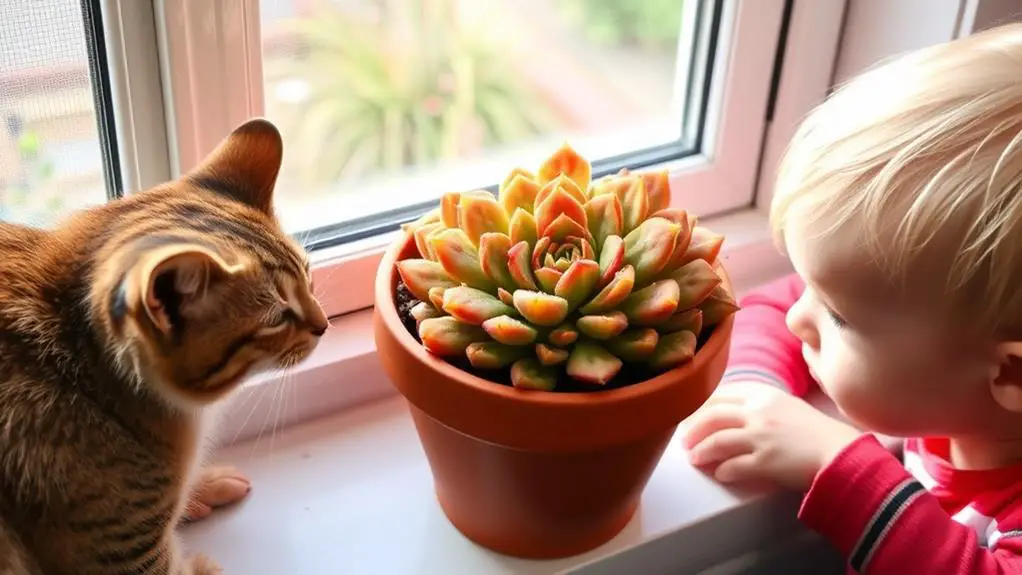
When considering the safety and toxicity of Graptosedum 'California Sunset,' you'll be pleased to know it's non-toxic to humans, cats, and dogs, making it a safe addition to any pet-friendly household.
While ingestion is generally harmless, some people might experience mild sensitivities. To guarantee safety, keep this plant out of reach of children and pets to prevent any accidental ingestion.
Even though Graptosedum 'California Sunset' poses no known harmful effects, it's always wise to exercise general caution with all houseplants. This will help maintain peace of mind, whether the plant is indoors or outdoors.
Frequently Asked Questions
How to Care for Graptosedum California Sunset?
Place your Graptosedum 'California Sunset' in bright sunlight, water every 12 days, and use well-draining soil. Fertilize monthly during growth periods. Watch for yellowing or shriveling leaves to adjust care and maintain plant health.
How to Take Care of a California Sunset?
Place your California Sunset in bright, direct sunlight for 4-6 hours daily. Water sparingly using the soak and dry method, and use well-draining soil. Fertilize during the growing season, and watch for signs of overwatering.
How to Care for a Sunset Plant?
Place your Sunset plant in bright sunlight for 4-6 hours daily. Water sparingly, letting soil dry out between waterings. Use well-draining soil and fertilize monthly during growth. Watch for stress signs like yellow leaves.
How to Care for Graptosedum?
Make certain your Graptosedum gets bright, direct sunlight for 4-6 hours daily. Water sparingly, allowing soil to dry out between waterings. Use well-draining soil and fertilize lightly during the growing season. Monitor for overwatering signs.
Conclusion
Taking care of your Graptosedum 'California Sunset' can be rewarding and fun. Remember to give it plenty of sunlight, water wisely, and use the right soil. Keep an eye on temperature and pests, and don't forget to prune and fertilize. With these tips, your plant will thrive, adding beauty to your space. You've got this! Happy gardening!

